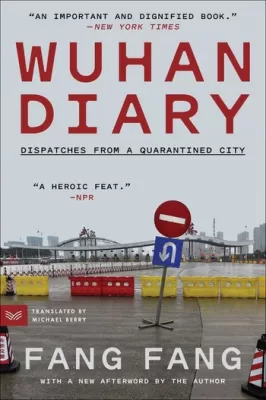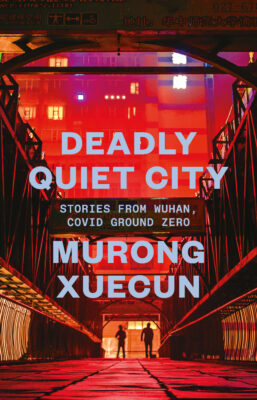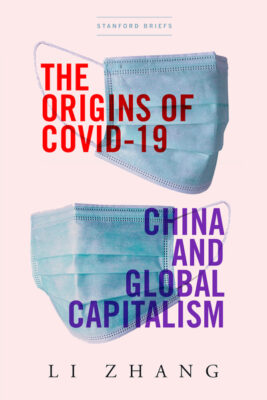This first part of Pandemic Discourses’ Best Reads List covers the development of the COVID-19 Pandemic during its early days in China. These specific readings were selected out of many great candidates due to their unique perspectives on the effects of the pandemic on a human as well as societal level.

Mark Frazier
Wuhan Diary: Dispatches from a Quarantined City
Fang Fang (Translated by Michael Berry)
Harper Collins, 2020, price, 416 pages
Deadly Quiet City: Stories from Wuhan, Covid Ground Zero
Murong Xuecun
Hardie Grant Publishing, 2022, 322 pages
The Origins of Covid-19: China and Global Capitalism
Li Zhang
Stanford University Press, 2021, 196 pages

Wuhan Diary: Dispatches from a Quarantined City
This trio of books brings the reader to “ground zero” of the pandemic, the city of Wuhan in early 2020. They prompt numerous ‘what ifs’ about the course of the pandemic: What if local officials had disclosed what they knew about the virus in late 2019? What if they had relayed information about the virus to China’s Center for Disease Control in Beijing, as mandated in regulations? What if they had issued warnings to the public sooner instead of actively suppressing information being circulated by health care workers and others? These accounts of Wuhan’s 76 day lockdown from late January to early April 2020 also foreshadow what would become a way of life for much of the rest of the world by spring 2020: the powerful sense of daily routines upended; fears and rumors regarding how the virus was spreading; check-ins with neighbors, friends, and family who were infected; and frustration as assurances from officials one day were contradicted the next, and lockdowns extended from days to weeks to a seemingly indefinite horizon.
Some readers are likely familiar with the celebrated Chinese novelist Fang Fang, who began posting on social media about her daily reflections, conversations with friends, encounters with neighborhood officials, and updates on the precarious health condition of relatives and neighbors. Her posts, which remained uncensored, drew an estimated 380 million views by April 2020. In addition, followers on China’s social media platforms shared her posts widely across WeChat groups.
As literary translator Michael Berry relates in the afterword of the translation of Fang’s posts, his own project to translate one of Fang’s novels was quickly sidelined as they agreed that he would attempt to translate her posts for eventual publication. As he began translating Fang’s early posts about a month after she started, his own city (Los Angeles) and country went into lockdown in March 2020.
Fang’s quotidian accounts of life during lockdown in Wuhan portray the uncertainty and swift changes in emotions brought on by ever-changing information regarding the new coronavirus—the manner of its transmission, the speed with which it had spread, the risks to those infected, and to what extent the government was being truthful about what it knew. Were the latest public health guidelines a reflection of carefully considered responses to new information about the disease, or merely an instrument to preserve social stability? Fang also opines widely on the incompetence of local officials, the heroism of healthcare workers who flocked to Wuhan, and on the pandemic’s emotional toll in addition to its more obvious costs to life. In a prescient note that describes the position of many Chinese citizens today in opposing the government’s Zero Covid policy, on February 14, 2020, she wrote, “We need just a little more humanistic spirit . . . so that when someone is infected with coronavirus, a crowd of people doesn’t end up sealing their front door with a steel rod so that everyone is locked inside.” She was writing about spontaneous reactions by frightened residents at the time, but today it is the grassroots extension of the state, the Residents’ Committees, who seal up the doors of entire apartment blocks, districts, or entire cities in order to comply with Xi Jinping’s policy. Fang was predictably attacked on Chinese social media for allegedly bringing shame to Wuhan and to China, and for “spreading rumors.”

Deadly Quiet City: Stores from Wuhan, COVID Ground Zero
Another translation of an acclaimed Chinese writer on the early days of the pandemic in Wuhan comes from Hua Qun, who publishes under the pen name of Murong Xuecun. Murong traveled to the Wuhan immediately after its re-opening in early April 2020 and began conducting interviews until he was forced to flee the city under threat from local officials. He finished the project in Sichuan province before leaving China for London. The book consists of accounts from eight residents of Wuhan, including one whose daughter died from complications arising from a Covid-19 infection. The accounts, narrated in present tense from the perspective of each person profiled, reveal how ordinary citizens in Wuhan coped as word spread about the virus and cases spiked around the city. The book also includes an editor’s chronology that highlights critical decision points: when physicians first noticed the puzzling case of viral pneumonia in December 2019 and reported it to the Wuhan Health Commission; when the local ophthalmologist Li Wenliang was reprimanded for telling colleagues about the new virus; when the Wuhan Health Commission announced the pneumonia cases with an unknown cause had surfaced but that no medical staff were infected and human transmission was unlikely; when the central government finally issued word on January 20 that the virus was highly contagious and ordered the lockdown in Wuhan on January 23.
Surprisingly, Deadly Quiet City was published by the Australian media company Hardie Grant and has had very limited exposure and attention from American media but has been reviewed in leading newspapers in Canada and Australia.

Origins of COVID-19: China and Global Capitalism
While Wuhan Diary and Deadly Quiet City strongly suggest that the spread of the coronavirus could have been limited had local officials not distorted or hidden crucial information from public health authorities in Beijing, the development sociologist and food supply researcher Li Zhang provides a different analytical perspective. She argues that the convergence of profit-driven global food supply chains; a closer human-wildlife interface arising from the erasure of habitat; the commercialization of wildlife stocks for food and medicine ingredients; and the logic of profit-driven biomedical research all made the Covid-19 pandemic more or less inevitable—and future pandemics likely. By this argument, the new coronavirus could have emerged anywhere, but the probabilities that it would do so in China were higher given the geographies of wildlife farming, biomedical research practices, and rapid urbanization putting humans and wildlife production circuits in close proximity.
In Chapter 3, Zhang’s account of the outbreak in Wuhan, she reinforces the claim that the course of the pandemic might have changed had early information about the virus not been suppressed. But she also condemns both the racialized western depictions of Chinese food consumption habits as somehow bringing culpability for the virus to China, and the Chinese government’s subsequent triumphalist narrative that it had defeated the virus through superior governance and mobilization. Her concluding chapter argues for dismantling global food-production systems that destroy biodiversity and encourage trade in wildlife. She also levels a broader critique at profit-driven biomedical science: the Covid-19 pandemic, and threats of future pandemics, “will continue to drive geopolitical struggles and competition over the power and profits generated by biomedical science” until cooperation can overcome geopolitical competition and public interests can supplant private profit-driven healthcare systems.
